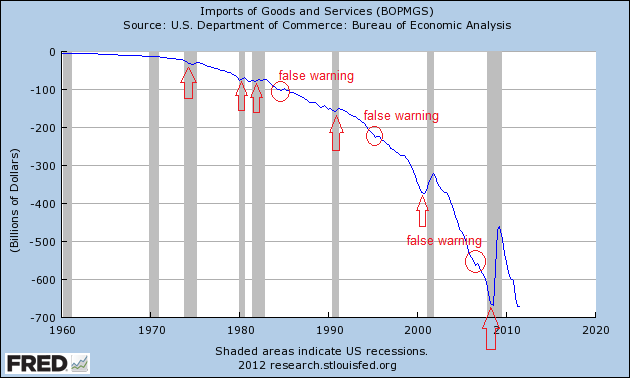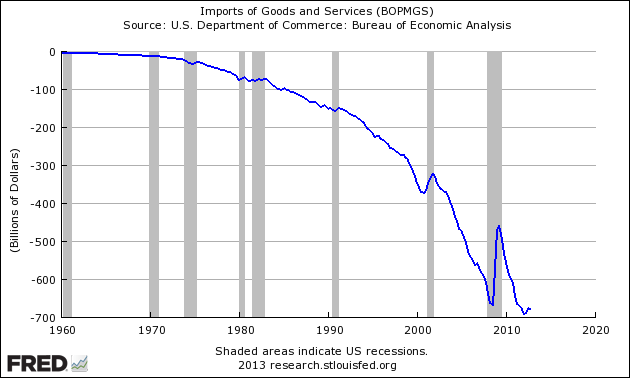Our analysis is better than the headlines. A quick recap to the April 2013 trade data released yesterday:
- Import growth has positive implications historically to the economy – and the seasonally adjusted imports were reported up month-over-month. Econintersect analysis shows an expansion of 8.7% month-over-month (unadjusted data offsetting last months decline of 7.2%) – with the year-over-year expansion at 0.7%.
- Exports were reported up, and Econintersect analysis shows exports up 4.3% month-over-month – year-over-year expansion at 1.8%.
- When an inflation adjustment is made to the unadjusted data – it becomes even rosier as prices are deflating.
- Consumer goods lead both import and export growth .
- The market expected a trade deficit of $41.0 billion and the seasonally adjusted headline deficit from US Census came in at a $40.3 billion deficit.
- The bottom line is that imports and exports (inflation adjusted) have rebounded from six months of bad data – and are expanding. However, one month of good data is not a trend.
- It should be noted that oil imports were up 18 million barrels from last month, and down 37 million barrels from one year ago.
There is a real year-over-year expansion in both exports and imports.
The headline data is not inflation adjusted. Here is a view of inflation adjusted imports and exports.
Inflation Adjusted Year-over-Year Change Exports (blue line), Imports less Oil (red line), and Imports with Oil (yellow line)
Growing exports is a sign of an expanding global economy (or at least a sign of growing competitiveness). From the press release:
The U.S. Census Bureau and the U.S. Bureau of Economic Analysis, through the Department of Commerce, announced today that total April exports of $187.4 billion and imports of $227.7 billion resulted in a goods and services deficit of $40.3 billion, up from $37.1 billion in March, revised. April exports were $2.2 billion more than March exports of $185.2 billion. April imports were $5.4 billion more than March imports of $222.3 billion.
In April, the goods deficit increased $3.2 billion from March to $58.6 billion, and the services surplus increased $0.1 billion from March to $18.3 billion. Exports of goods increased $1.8 billion to $131.1 billion, and imports of goods increased $5.0 billion to $189.7 billion. Exports of services increased $0.4 billion to $56.3 billion, and imports of services increased $0.3 billion to $38.0 billion.
The goods and services deficit decreased $6.3 billion from April 2012 to April 2013. Exports were up $3.1 billion, or 1.7 percent, and imports were down $3.2 billion, or 1.4 percent.
Econintersect analysis is based on the unadjusted data.
Unadjusted Total Imports (blue line), Exports (red line) and Trade Balance (green line) – Not Inflation Adjusted
Indexing the data to the end of the recession, here is a look at the relative growth of imports and exports using current dollars as the basis for the index.
Unadjusted Total Imports (blue line), Exports (red line) and Trade Balance (green line) indexed to the End of Recession – Not Inflation Adjusted
Econintersect is most concerned with imports as there is a clear recession link to import contraction. Adjusting for cost inflation allows apples-to-apples comparisons in equal value dollars between periods. The graph below uses seasonally adjusted data is in direct contradiction to the unadjusted data year-over-year data which shows contraction.
Seasonally and Inflation Adjusted Year-over-Year Change Imports (blue line) and Exports (red line)
As shown in the above graph:
- import growth was trending up since mid-2011 – but the data now seems to be showing a downward trend line.
- Exports have been in a downtrend since mid-2010.
- April data looks like a reversal of the downtrends, but one month of data is not a trend.
Note: This is a rear view look at the economy – however, imports do have a forward vision of up to three months ahead of expected economic activity.
Caveats on Using this Trade Data Index
The data is not inflation adjusted. Econintersect applies the BLS export – import price indices to the data to adjust for inflation – total exports, total imports, and imports less oil. Adjusting for cost inflation allows apples-to-apples comparisons in equal value dollars between periods.
Although Econintersect generally disagrees with the seasonal adjustment methodology of U.S. Census, in general this methodology works for this trade data series as the data is not as noisy as other series. Another positive aspect of this series is that backward revision has usually been very minor.
Econintersect determines the month-over-month change by subtracting the current month’s year-over-year change from the previous month’s year-over-year change. This is the best of the bad options available to determine month-over-month trends – as the preferred methodology would be to use multi-year data (but the New Normal effects and the Great Recession distort historical data).
Oil prices, and also quantities of imported oil, wobble excessively year-over-year and month-over-month. In 2010, the percent of oil imports varied between 10.4% and 14.6% of the total. In 2008 the variance was between 11.5% to over 20%. No amount of adjusting – short of removing oil imports from the analysis – allows a clear picture of imports.
Contracting imports historically is a recession marker, as consumers and business start to hunker down. Main Street and Wall Street are not necessarily in phase and imports can reflect the direction for Main Street when Wall Street may be saying something different. During some recessions, consumers and businesses hunkered down before the Wall Street recession hit – but in the 2007 recession the Main Street contraction began 10 months after the recession officially started. [Graph below is updated through 3Q2011.]
Above graph with current data:
Imports of Goods and Services
